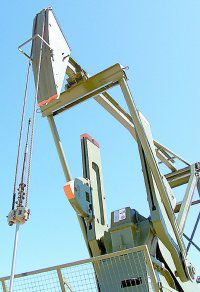| ConocoPhillips currently has 480 producing gas wells in the Carbon and Emery County area as part of the company’s Drunkards Wash development project. |
ConocoPhillips is a relatively new name in Carbon and Emery counties, but drilling for coalbed methane gas has been a part of local energy culture for quite sometime.
Phillips Petroleum Company purchased River Gas in 2000 and soon began merger negotiations with Conoco. The merger was completed in August 2002, following approval by the United States Federal Trade Commission.
ConocoPhillips representatives met recently with a group of community leaders and industry partners to discuss the merger and the future. Richard Newsom, asset manager for ConocoPhillips, addressed the group.
“At Drunkards Wash, we have plateaued in gas production and actually showed a slight decrease in production in 2002,” explained Newsom.
Due to lower than anticipated reserves on existing wells, there is a significant decline in base production. Current performance is not getting the job done, leaving the company with two options. The options are to downsize in terms of drilling wells or utilize an advanced process known as multilateral technology. Last year, the company planned 55 new production wells, but drilled only 48.
Last year was disappointing for the company. The fewer wells were due to permitting and partner issues.
“We can’t duplicate what we did last year,” stated Newsom.
Since the conventional approach to drilling appears to be ineffective, Newsom announced a new strategy in drilling in the Drunkards Wash project. Called multilateral technology by the industry, the process will be new to the ConocoPhillips’ operation in the local area.
“By no means is this a slam dunk,” stated Newsom.
Significant challenges will accompany the technology. However, the technique has a proven record of higher recovery rates and should result in faster dewatering in coalbed methane applications. If successful, it will increase the net present value of the project.
Well costs are expected to double and possibly be even three times more costly to drill. But there will be fewer wells.
The process was described like a “fishbone” where laterals will kick off the main line, like ribs of a fish. Not only is the technique expected to improve production, but the process will be more environmentally friendly due to fewer wells.
The Drunkards Wash project making up the Uinta Basin team employs 53 people in Carbon and Emery counties. The project has 480 wells pumping 190 million cubic feet daily and producing 48 thousand barrels of water. Water is injected back into the wells.
Project ownership consists of ConocoPhillip, Chevron Texaco and Dominion. ConocoPhillips is the operator of the field.
During the recent informational session, Newsom discussed the merger overview and outlined the merits of joining the companies.
“What has emerged is a major energy company which put us in a different league or weight class,” noted Newsom. “We are now an integrated major. It has brought together two complementary portfolios of legacy positions and formed a company that just makes sense.”
A management team with global presence in refining and marketing along with a combination of two technological leaders with portfolios in growth and opportunities give the company leverage to do the things it wants to do.
The company is maintaining a focus on safety and remains committed to achieving operating excellence, pointed out Newsom.
Local ConocoPhillips manager Kevin Snow indicated that Castle Valley is a complex geological area. He highlighted the process of drilling the methane stored in the structure of coal. In the process, the pressure of the water is lowered, allowing the gas to desorb from the coal and pumped out.
ConocoPhillips indicated the company has 41 proposed wells targeted to drill in 2003. Seven are carryovers from last year.
“Just because we have these proposed, doesn’t mean they will all be drilled,” pointed out Newsom.
If multilateral drilling is successful, ConocoPhillips might advocate switching the remainder of the wells to this method.
Last year, the company was successful in drilling two directional wells, which is a method similar to multilateral drilling, but not as sophisticated.
“We are open to ideas, trying to reach our goals and believe that technology could be the key future here in the basin”, Newsom concluded.

